Analyzing Globalization's Impact on Inequalities in the 21st Century
VerifiedAdded on 2022/08/29
|9
|2427
|14
Essay
AI Summary
This essay explores the multifaceted effects of globalization on income inequality in the 21st century. It examines the role of global trade, cross-border investment, and labor movements in creating income disparities, using metrics like the Gini and Palma ratios to measure inequality. The essay discusses how specialization and trade can lead to both economic growth and increased relative poverty, analyzing the impact of multinational corporations, tax avoidance, and the demand for skilled labor. It further investigates the effects of globalization on employment, wages, and the rise of expatriates. The study also includes a focus on Nigeria, exploring how globalization affects its economy and the transition of expatriates. The essay concludes by emphasizing the need for governments to implement policies that address inequalities and ensure that the benefits of globalization are shared more equitably.
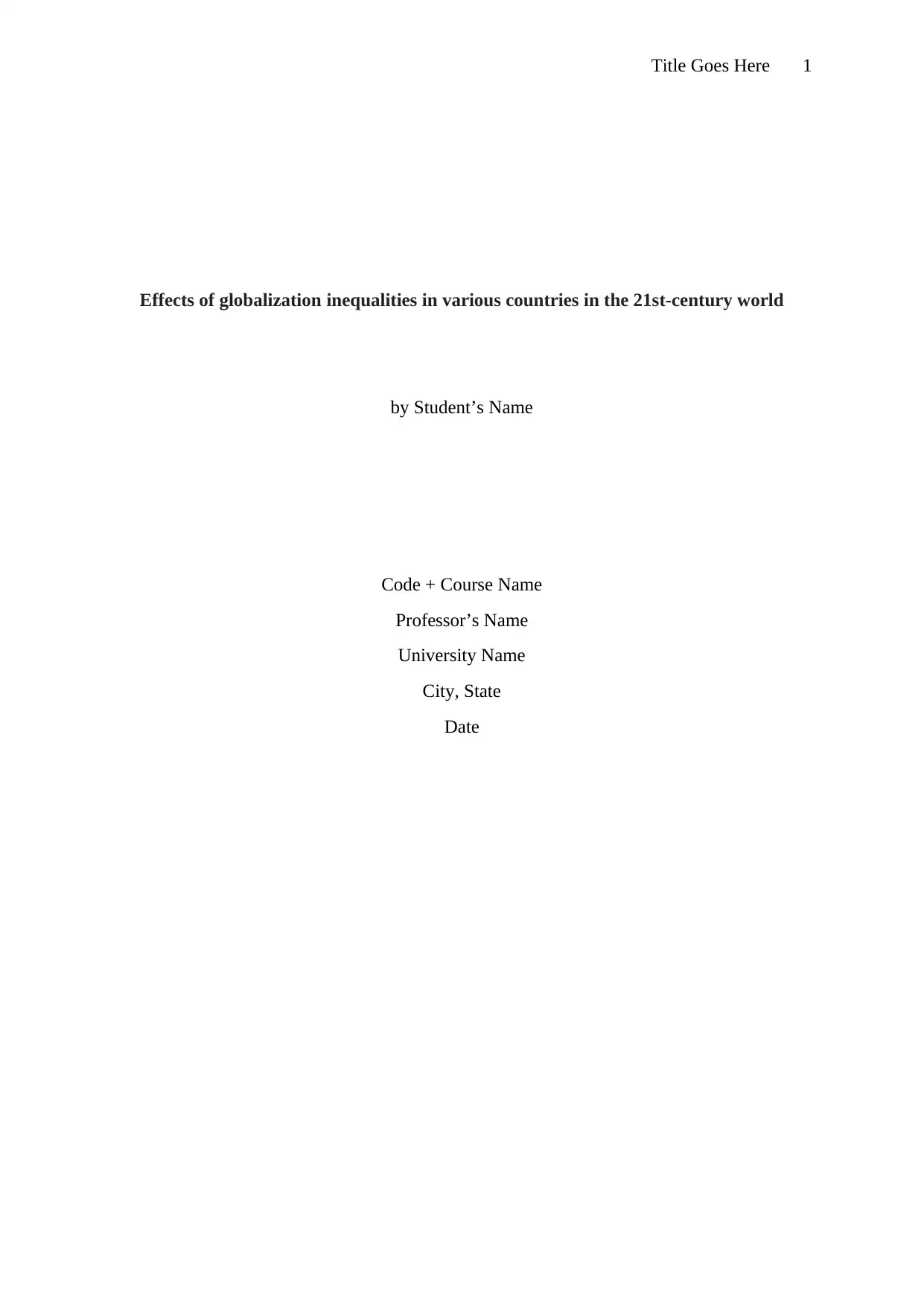
Title Goes Here 1
Effects of globalization inequalities in various countries in the 21st-century world
by Student’s Name
Code + Course Name
Professor’s Name
University Name
City, State
Date
Effects of globalization inequalities in various countries in the 21st-century world
by Student’s Name
Code + Course Name
Professor’s Name
University Name
City, State
Date
Paraphrase This Document
Need a fresh take? Get an instant paraphrase of this document with our AI Paraphraser
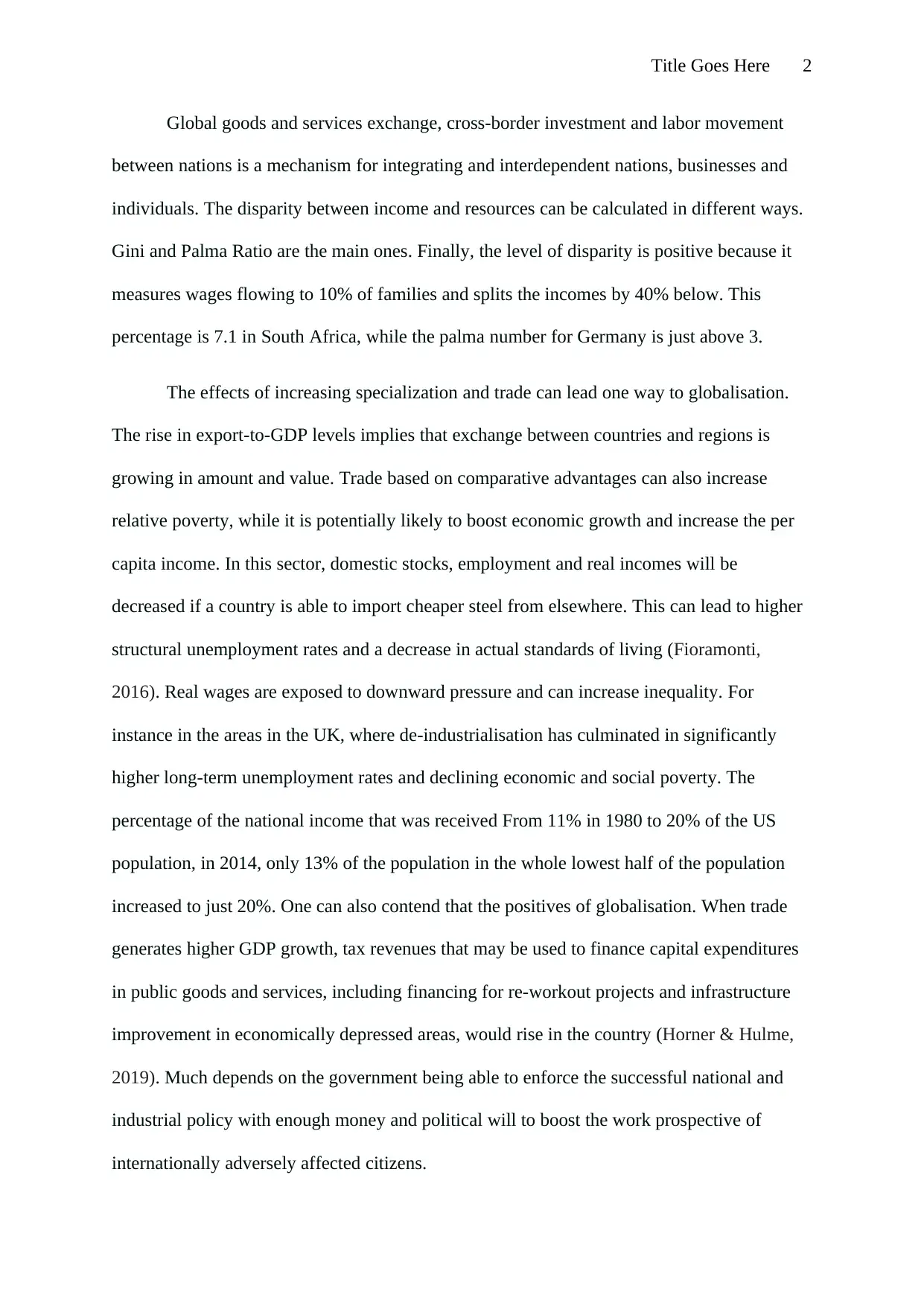
Title Goes Here 2
Global goods and services exchange, cross-border investment and labor movement
between nations is a mechanism for integrating and interdependent nations, businesses and
individuals. The disparity between income and resources can be calculated in different ways.
Gini and Palma Ratio are the main ones. Finally, the level of disparity is positive because it
measures wages flowing to 10% of families and splits the incomes by 40% below. This
percentage is 7.1 in South Africa, while the palma number for Germany is just above 3.
The effects of increasing specialization and trade can lead one way to globalisation.
The rise in export-to-GDP levels implies that exchange between countries and regions is
growing in amount and value. Trade based on comparative advantages can also increase
relative poverty, while it is potentially likely to boost economic growth and increase the per
capita income. In this sector, domestic stocks, employment and real incomes will be
decreased if a country is able to import cheaper steel from elsewhere. This can lead to higher
structural unemployment rates and a decrease in actual standards of living (Fioramonti,
2016). Real wages are exposed to downward pressure and can increase inequality. For
instance in the areas in the UK, where de-industrialisation has culminated in significantly
higher long-term unemployment rates and declining economic and social poverty. The
percentage of the national income that was received From 11% in 1980 to 20% of the US
population, in 2014, only 13% of the population in the whole lowest half of the population
increased to just 20%. One can also contend that the positives of globalisation. When trade
generates higher GDP growth, tax revenues that may be used to finance capital expenditures
in public goods and services, including financing for re-workout projects and infrastructure
improvement in economically depressed areas, would rise in the country (Horner & Hulme,
2019). Much depends on the government being able to enforce the successful national and
industrial policy with enough money and political will to boost the work prospective of
internationally adversely affected citizens.
Global goods and services exchange, cross-border investment and labor movement
between nations is a mechanism for integrating and interdependent nations, businesses and
individuals. The disparity between income and resources can be calculated in different ways.
Gini and Palma Ratio are the main ones. Finally, the level of disparity is positive because it
measures wages flowing to 10% of families and splits the incomes by 40% below. This
percentage is 7.1 in South Africa, while the palma number for Germany is just above 3.
The effects of increasing specialization and trade can lead one way to globalisation.
The rise in export-to-GDP levels implies that exchange between countries and regions is
growing in amount and value. Trade based on comparative advantages can also increase
relative poverty, while it is potentially likely to boost economic growth and increase the per
capita income. In this sector, domestic stocks, employment and real incomes will be
decreased if a country is able to import cheaper steel from elsewhere. This can lead to higher
structural unemployment rates and a decrease in actual standards of living (Fioramonti,
2016). Real wages are exposed to downward pressure and can increase inequality. For
instance in the areas in the UK, where de-industrialisation has culminated in significantly
higher long-term unemployment rates and declining economic and social poverty. The
percentage of the national income that was received From 11% in 1980 to 20% of the US
population, in 2014, only 13% of the population in the whole lowest half of the population
increased to just 20%. One can also contend that the positives of globalisation. When trade
generates higher GDP growth, tax revenues that may be used to finance capital expenditures
in public goods and services, including financing for re-workout projects and infrastructure
improvement in economically depressed areas, would rise in the country (Horner & Hulme,
2019). Much depends on the government being able to enforce the successful national and
industrial policy with enough money and political will to boost the work prospective of
internationally adversely affected citizens.
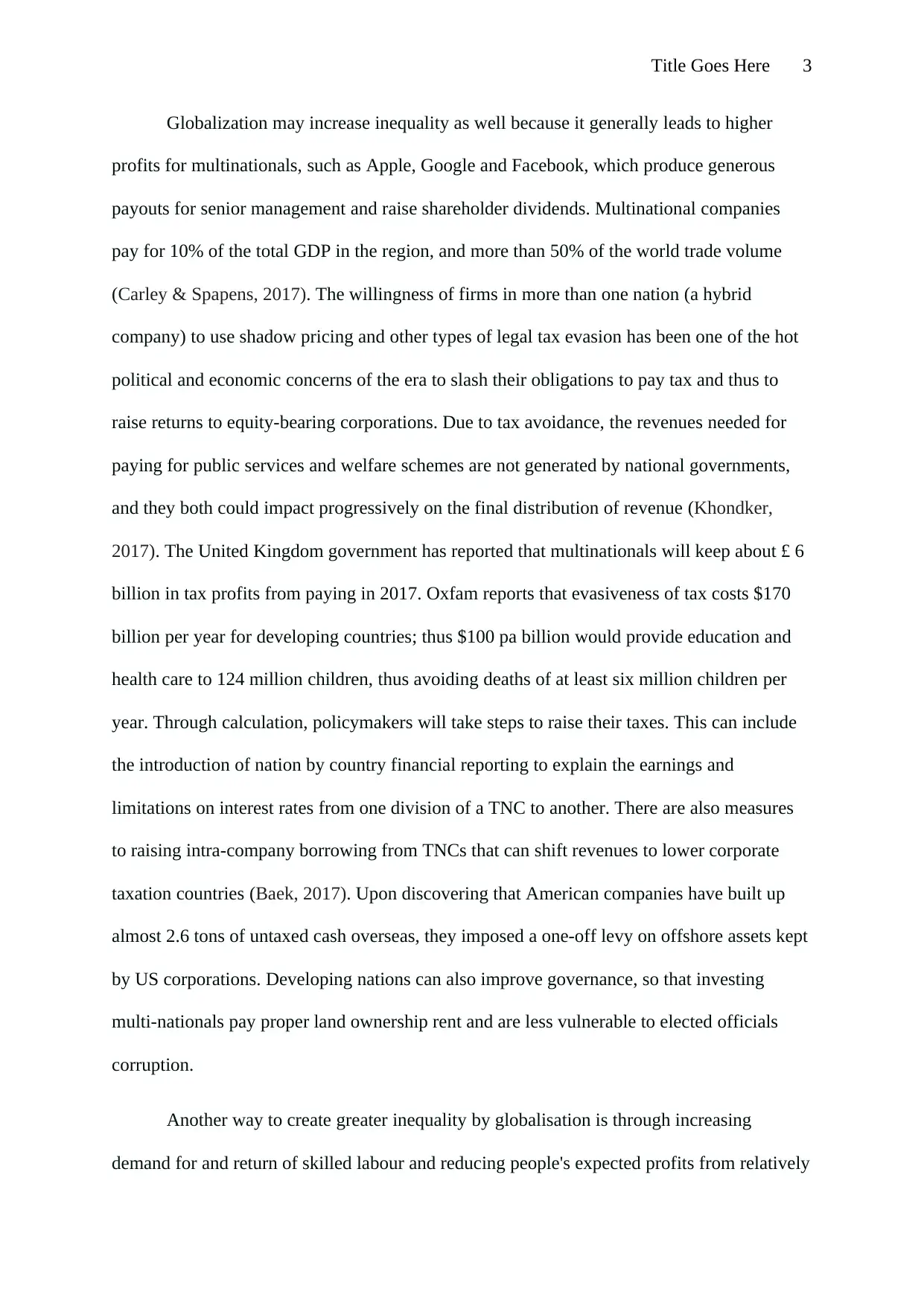
Title Goes Here 3
Globalization may increase inequality as well because it generally leads to higher
profits for multinationals, such as Apple, Google and Facebook, which produce generous
payouts for senior management and raise shareholder dividends. Multinational companies
pay for 10% of the total GDP in the region, and more than 50% of the world trade volume
(Carley & Spapens, 2017). The willingness of firms in more than one nation (a hybrid
company) to use shadow pricing and other types of legal tax evasion has been one of the hot
political and economic concerns of the era to slash their obligations to pay tax and thus to
raise returns to equity-bearing corporations. Due to tax avoidance, the revenues needed for
paying for public services and welfare schemes are not generated by national governments,
and they both could impact progressively on the final distribution of revenue (Khondker,
2017). The United Kingdom government has reported that multinationals will keep about £ 6
billion in tax profits from paying in 2017. Oxfam reports that evasiveness of tax costs $170
billion per year for developing countries; thus $100 pa billion would provide education and
health care to 124 million children, thus avoiding deaths of at least six million children per
year. Through calculation, policymakers will take steps to raise their taxes. This can include
the introduction of nation by country financial reporting to explain the earnings and
limitations on interest rates from one division of a TNC to another. There are also measures
to raising intra-company borrowing from TNCs that can shift revenues to lower corporate
taxation countries (Baek, 2017). Upon discovering that American companies have built up
almost 2.6 tons of untaxed cash overseas, they imposed a one-off levy on offshore assets kept
by US corporations. Developing nations can also improve governance, so that investing
multi-nationals pay proper land ownership rent and are less vulnerable to elected officials
corruption.
Another way to create greater inequality by globalisation is through increasing
demand for and return of skilled labour and reducing people's expected profits from relatively
Globalization may increase inequality as well because it generally leads to higher
profits for multinationals, such as Apple, Google and Facebook, which produce generous
payouts for senior management and raise shareholder dividends. Multinational companies
pay for 10% of the total GDP in the region, and more than 50% of the world trade volume
(Carley & Spapens, 2017). The willingness of firms in more than one nation (a hybrid
company) to use shadow pricing and other types of legal tax evasion has been one of the hot
political and economic concerns of the era to slash their obligations to pay tax and thus to
raise returns to equity-bearing corporations. Due to tax avoidance, the revenues needed for
paying for public services and welfare schemes are not generated by national governments,
and they both could impact progressively on the final distribution of revenue (Khondker,
2017). The United Kingdom government has reported that multinationals will keep about £ 6
billion in tax profits from paying in 2017. Oxfam reports that evasiveness of tax costs $170
billion per year for developing countries; thus $100 pa billion would provide education and
health care to 124 million children, thus avoiding deaths of at least six million children per
year. Through calculation, policymakers will take steps to raise their taxes. This can include
the introduction of nation by country financial reporting to explain the earnings and
limitations on interest rates from one division of a TNC to another. There are also measures
to raising intra-company borrowing from TNCs that can shift revenues to lower corporate
taxation countries (Baek, 2017). Upon discovering that American companies have built up
almost 2.6 tons of untaxed cash overseas, they imposed a one-off levy on offshore assets kept
by US corporations. Developing nations can also improve governance, so that investing
multi-nationals pay proper land ownership rent and are less vulnerable to elected officials
corruption.
Another way to create greater inequality by globalisation is through increasing
demand for and return of skilled labour and reducing people's expected profits from relatively
⊘ This is a preview!⊘
Do you want full access?
Subscribe today to unlock all pages.

Trusted by 1+ million students worldwide
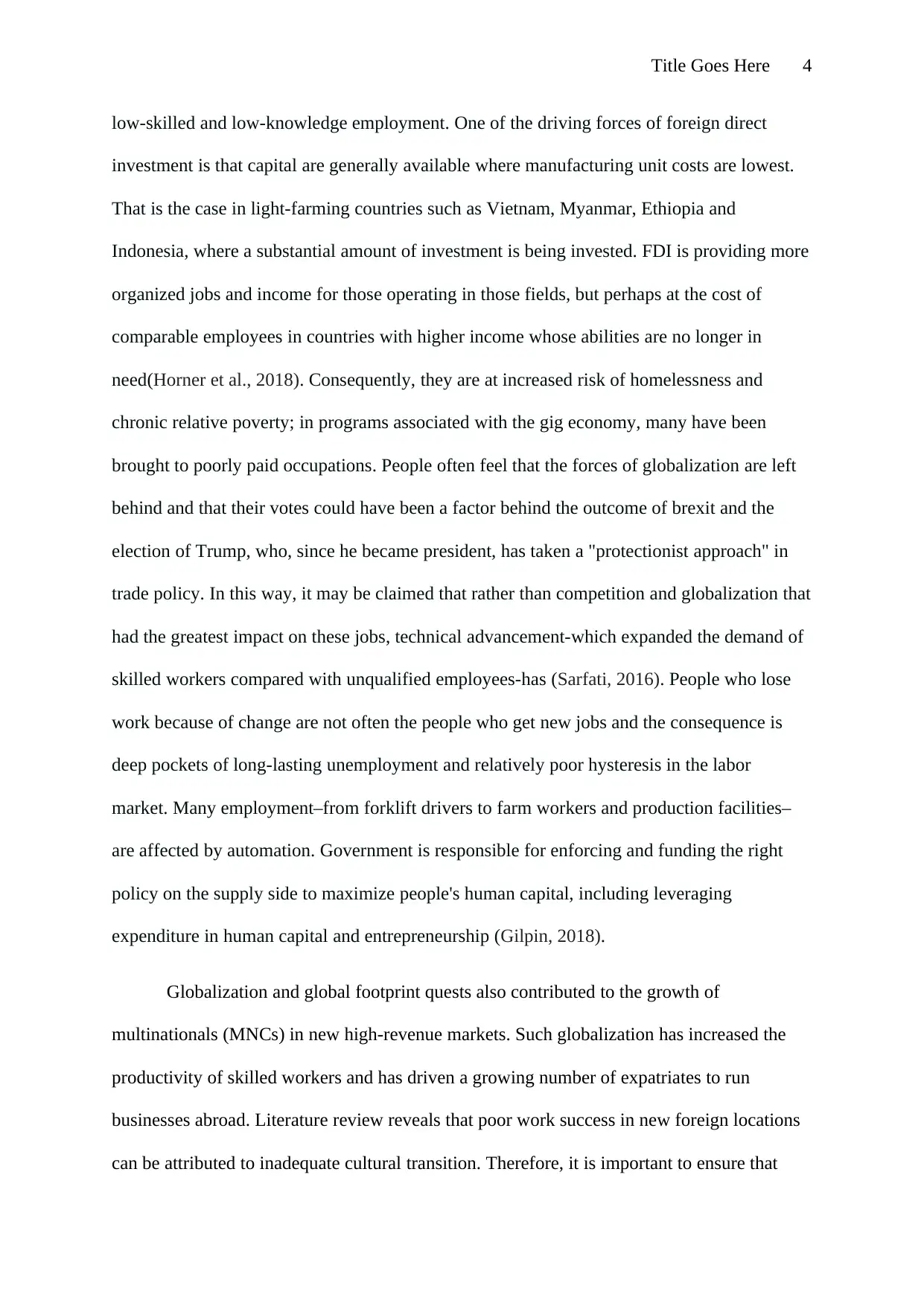
Title Goes Here 4
low-skilled and low-knowledge employment. One of the driving forces of foreign direct
investment is that capital are generally available where manufacturing unit costs are lowest.
That is the case in light-farming countries such as Vietnam, Myanmar, Ethiopia and
Indonesia, where a substantial amount of investment is being invested. FDI is providing more
organized jobs and income for those operating in those fields, but perhaps at the cost of
comparable employees in countries with higher income whose abilities are no longer in
need(Horner et al., 2018). Consequently, they are at increased risk of homelessness and
chronic relative poverty; in programs associated with the gig economy, many have been
brought to poorly paid occupations. People often feel that the forces of globalization are left
behind and that their votes could have been a factor behind the outcome of brexit and the
election of Trump, who, since he became president, has taken a "protectionist approach" in
trade policy. In this way, it may be claimed that rather than competition and globalization that
had the greatest impact on these jobs, technical advancement-which expanded the demand of
skilled workers compared with unqualified employees-has (Sarfati, 2016). People who lose
work because of change are not often the people who get new jobs and the consequence is
deep pockets of long-lasting unemployment and relatively poor hysteresis in the labor
market. Many employment–from forklift drivers to farm workers and production facilities–
are affected by automation. Government is responsible for enforcing and funding the right
policy on the supply side to maximize people's human capital, including leveraging
expenditure in human capital and entrepreneurship (Gilpin, 2018).
Globalization and global footprint quests also contributed to the growth of
multinationals (MNCs) in new high-revenue markets. Such globalization has increased the
productivity of skilled workers and has driven a growing number of expatriates to run
businesses abroad. Literature review reveals that poor work success in new foreign locations
can be attributed to inadequate cultural transition. Therefore, it is important to ensure that
low-skilled and low-knowledge employment. One of the driving forces of foreign direct
investment is that capital are generally available where manufacturing unit costs are lowest.
That is the case in light-farming countries such as Vietnam, Myanmar, Ethiopia and
Indonesia, where a substantial amount of investment is being invested. FDI is providing more
organized jobs and income for those operating in those fields, but perhaps at the cost of
comparable employees in countries with higher income whose abilities are no longer in
need(Horner et al., 2018). Consequently, they are at increased risk of homelessness and
chronic relative poverty; in programs associated with the gig economy, many have been
brought to poorly paid occupations. People often feel that the forces of globalization are left
behind and that their votes could have been a factor behind the outcome of brexit and the
election of Trump, who, since he became president, has taken a "protectionist approach" in
trade policy. In this way, it may be claimed that rather than competition and globalization that
had the greatest impact on these jobs, technical advancement-which expanded the demand of
skilled workers compared with unqualified employees-has (Sarfati, 2016). People who lose
work because of change are not often the people who get new jobs and the consequence is
deep pockets of long-lasting unemployment and relatively poor hysteresis in the labor
market. Many employment–from forklift drivers to farm workers and production facilities–
are affected by automation. Government is responsible for enforcing and funding the right
policy on the supply side to maximize people's human capital, including leveraging
expenditure in human capital and entrepreneurship (Gilpin, 2018).
Globalization and global footprint quests also contributed to the growth of
multinationals (MNCs) in new high-revenue markets. Such globalization has increased the
productivity of skilled workers and has driven a growing number of expatriates to run
businesses abroad. Literature review reveals that poor work success in new foreign locations
can be attributed to inadequate cultural transition. Therefore, it is important to ensure that
Paraphrase This Document
Need a fresh take? Get an instant paraphrase of this document with our AI Paraphraser
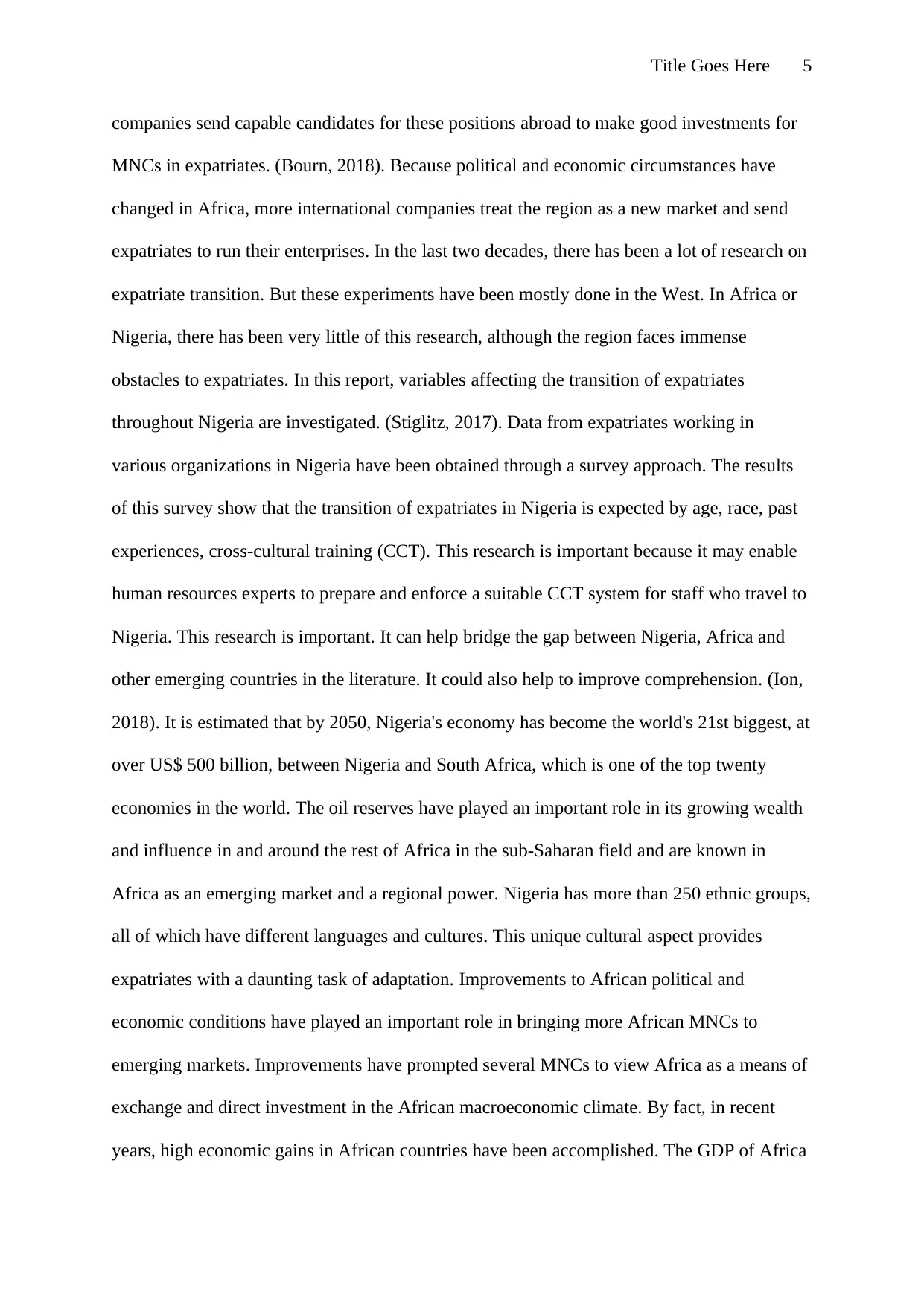
Title Goes Here 5
companies send capable candidates for these positions abroad to make good investments for
MNCs in expatriates. (Bourn, 2018). Because political and economic circumstances have
changed in Africa, more international companies treat the region as a new market and send
expatriates to run their enterprises. In the last two decades, there has been a lot of research on
expatriate transition. But these experiments have been mostly done in the West. In Africa or
Nigeria, there has been very little of this research, although the region faces immense
obstacles to expatriates. In this report, variables affecting the transition of expatriates
throughout Nigeria are investigated. (Stiglitz, 2017). Data from expatriates working in
various organizations in Nigeria have been obtained through a survey approach. The results
of this survey show that the transition of expatriates in Nigeria is expected by age, race, past
experiences, cross-cultural training (CCT). This research is important because it may enable
human resources experts to prepare and enforce a suitable CCT system for staff who travel to
Nigeria. This research is important. It can help bridge the gap between Nigeria, Africa and
other emerging countries in the literature. It could also help to improve comprehension. (Ion,
2018). It is estimated that by 2050, Nigeria's economy has become the world's 21st biggest, at
over US$ 500 billion, between Nigeria and South Africa, which is one of the top twenty
economies in the world. The oil reserves have played an important role in its growing wealth
and influence in and around the rest of Africa in the sub-Saharan field and are known in
Africa as an emerging market and a regional power. Nigeria has more than 250 ethnic groups,
all of which have different languages and cultures. This unique cultural aspect provides
expatriates with a daunting task of adaptation. Improvements to African political and
economic conditions have played an important role in bringing more African MNCs to
emerging markets. Improvements have prompted several MNCs to view Africa as a means of
exchange and direct investment in the African macroeconomic climate. By fact, in recent
years, high economic gains in African countries have been accomplished. The GDP of Africa
companies send capable candidates for these positions abroad to make good investments for
MNCs in expatriates. (Bourn, 2018). Because political and economic circumstances have
changed in Africa, more international companies treat the region as a new market and send
expatriates to run their enterprises. In the last two decades, there has been a lot of research on
expatriate transition. But these experiments have been mostly done in the West. In Africa or
Nigeria, there has been very little of this research, although the region faces immense
obstacles to expatriates. In this report, variables affecting the transition of expatriates
throughout Nigeria are investigated. (Stiglitz, 2017). Data from expatriates working in
various organizations in Nigeria have been obtained through a survey approach. The results
of this survey show that the transition of expatriates in Nigeria is expected by age, race, past
experiences, cross-cultural training (CCT). This research is important because it may enable
human resources experts to prepare and enforce a suitable CCT system for staff who travel to
Nigeria. This research is important. It can help bridge the gap between Nigeria, Africa and
other emerging countries in the literature. It could also help to improve comprehension. (Ion,
2018). It is estimated that by 2050, Nigeria's economy has become the world's 21st biggest, at
over US$ 500 billion, between Nigeria and South Africa, which is one of the top twenty
economies in the world. The oil reserves have played an important role in its growing wealth
and influence in and around the rest of Africa in the sub-Saharan field and are known in
Africa as an emerging market and a regional power. Nigeria has more than 250 ethnic groups,
all of which have different languages and cultures. This unique cultural aspect provides
expatriates with a daunting task of adaptation. Improvements to African political and
economic conditions have played an important role in bringing more African MNCs to
emerging markets. Improvements have prompted several MNCs to view Africa as a means of
exchange and direct investment in the African macroeconomic climate. By fact, in recent
years, high economic gains in African countries have been accomplished. The GDP of Africa
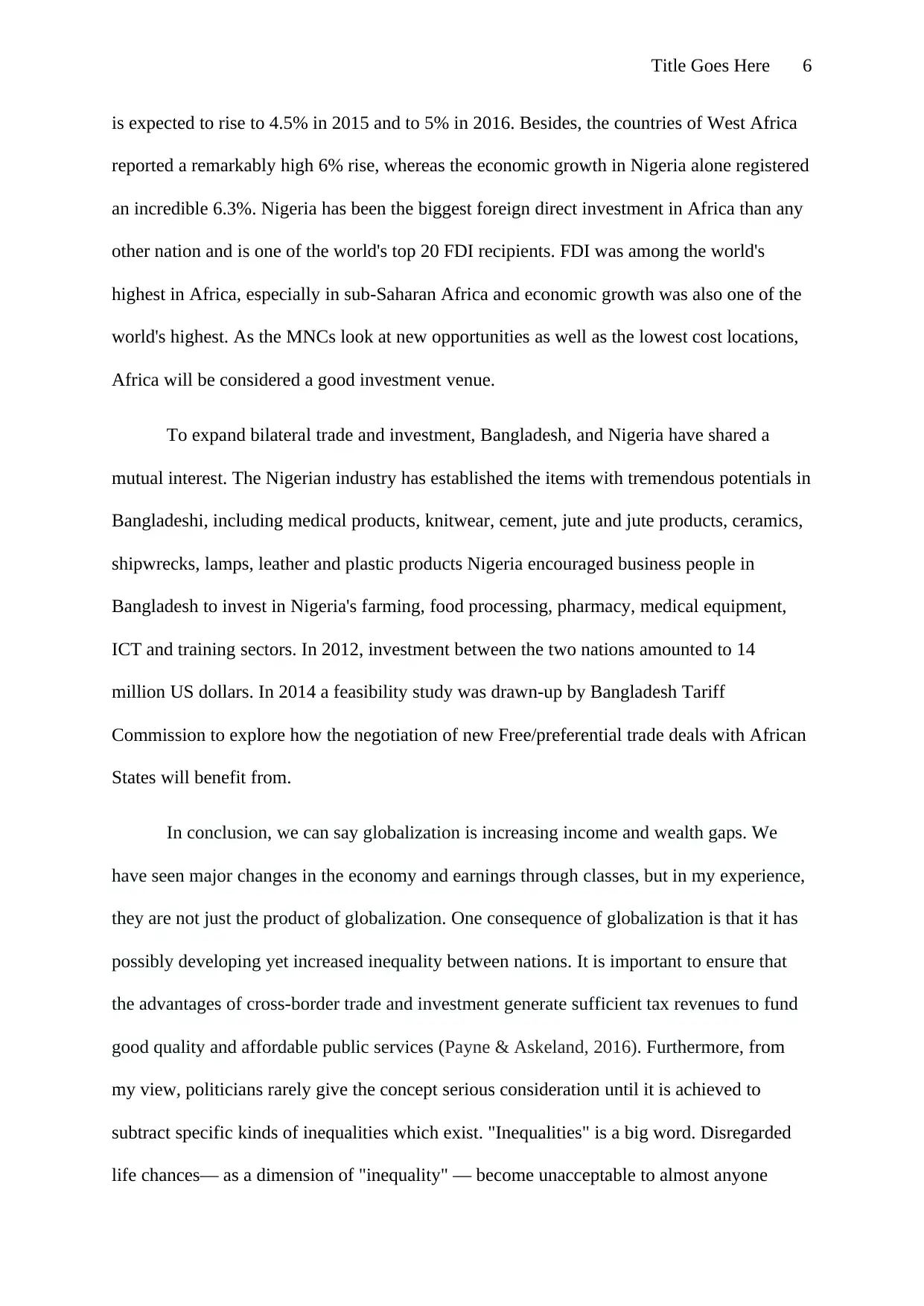
Title Goes Here 6
is expected to rise to 4.5% in 2015 and to 5% in 2016. Besides, the countries of West Africa
reported a remarkably high 6% rise, whereas the economic growth in Nigeria alone registered
an incredible 6.3%. Nigeria has been the biggest foreign direct investment in Africa than any
other nation and is one of the world's top 20 FDI recipients. FDI was among the world's
highest in Africa, especially in sub-Saharan Africa and economic growth was also one of the
world's highest. As the MNCs look at new opportunities as well as the lowest cost locations,
Africa will be considered a good investment venue.
To expand bilateral trade and investment, Bangladesh, and Nigeria have shared a
mutual interest. The Nigerian industry has established the items with tremendous potentials in
Bangladeshi, including medical products, knitwear, cement, jute and jute products, ceramics,
shipwrecks, lamps, leather and plastic products Nigeria encouraged business people in
Bangladesh to invest in Nigeria's farming, food processing, pharmacy, medical equipment,
ICT and training sectors. In 2012, investment between the two nations amounted to 14
million US dollars. In 2014 a feasibility study was drawn-up by Bangladesh Tariff
Commission to explore how the negotiation of new Free/preferential trade deals with African
States will benefit from.
In conclusion, we can say globalization is increasing income and wealth gaps. We
have seen major changes in the economy and earnings through classes, but in my experience,
they are not just the product of globalization. One consequence of globalization is that it has
possibly developing yet increased inequality between nations. It is important to ensure that
the advantages of cross-border trade and investment generate sufficient tax revenues to fund
good quality and affordable public services (Payne & Askeland, 2016). Furthermore, from
my view, politicians rarely give the concept serious consideration until it is achieved to
subtract specific kinds of inequalities which exist. "Inequalities" is a big word. Disregarded
life chances— as a dimension of "inequality" — become unacceptable to almost anyone
is expected to rise to 4.5% in 2015 and to 5% in 2016. Besides, the countries of West Africa
reported a remarkably high 6% rise, whereas the economic growth in Nigeria alone registered
an incredible 6.3%. Nigeria has been the biggest foreign direct investment in Africa than any
other nation and is one of the world's top 20 FDI recipients. FDI was among the world's
highest in Africa, especially in sub-Saharan Africa and economic growth was also one of the
world's highest. As the MNCs look at new opportunities as well as the lowest cost locations,
Africa will be considered a good investment venue.
To expand bilateral trade and investment, Bangladesh, and Nigeria have shared a
mutual interest. The Nigerian industry has established the items with tremendous potentials in
Bangladeshi, including medical products, knitwear, cement, jute and jute products, ceramics,
shipwrecks, lamps, leather and plastic products Nigeria encouraged business people in
Bangladesh to invest in Nigeria's farming, food processing, pharmacy, medical equipment,
ICT and training sectors. In 2012, investment between the two nations amounted to 14
million US dollars. In 2014 a feasibility study was drawn-up by Bangladesh Tariff
Commission to explore how the negotiation of new Free/preferential trade deals with African
States will benefit from.
In conclusion, we can say globalization is increasing income and wealth gaps. We
have seen major changes in the economy and earnings through classes, but in my experience,
they are not just the product of globalization. One consequence of globalization is that it has
possibly developing yet increased inequality between nations. It is important to ensure that
the advantages of cross-border trade and investment generate sufficient tax revenues to fund
good quality and affordable public services (Payne & Askeland, 2016). Furthermore, from
my view, politicians rarely give the concept serious consideration until it is achieved to
subtract specific kinds of inequalities which exist. "Inequalities" is a big word. Disregarded
life chances— as a dimension of "inequality" — become unacceptable to almost anyone
⊘ This is a preview!⊘
Do you want full access?
Subscribe today to unlock all pages.

Trusted by 1+ million students worldwide
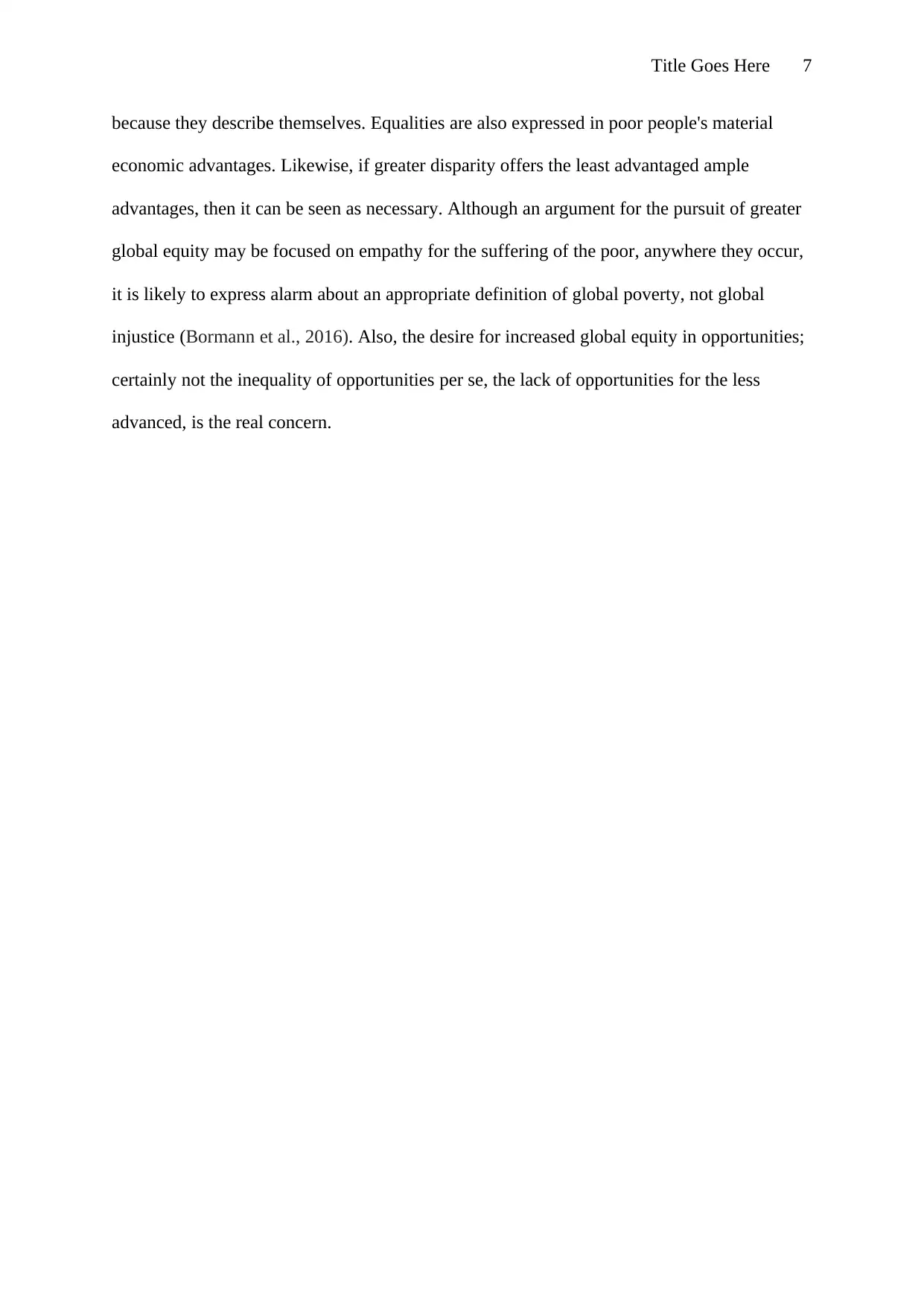
Title Goes Here 7
because they describe themselves. Equalities are also expressed in poor people's material
economic advantages. Likewise, if greater disparity offers the least advantaged ample
advantages, then it can be seen as necessary. Although an argument for the pursuit of greater
global equity may be focused on empathy for the suffering of the poor, anywhere they occur,
it is likely to express alarm about an appropriate definition of global poverty, not global
injustice (Bormann et al., 2016). Also, the desire for increased global equity in opportunities;
certainly not the inequality of opportunities per se, the lack of opportunities for the less
advanced, is the real concern.
because they describe themselves. Equalities are also expressed in poor people's material
economic advantages. Likewise, if greater disparity offers the least advantaged ample
advantages, then it can be seen as necessary. Although an argument for the pursuit of greater
global equity may be focused on empathy for the suffering of the poor, anywhere they occur,
it is likely to express alarm about an appropriate definition of global poverty, not global
injustice (Bormann et al., 2016). Also, the desire for increased global equity in opportunities;
certainly not the inequality of opportunities per se, the lack of opportunities for the less
advanced, is the real concern.
Paraphrase This Document
Need a fresh take? Get an instant paraphrase of this document with our AI Paraphraser
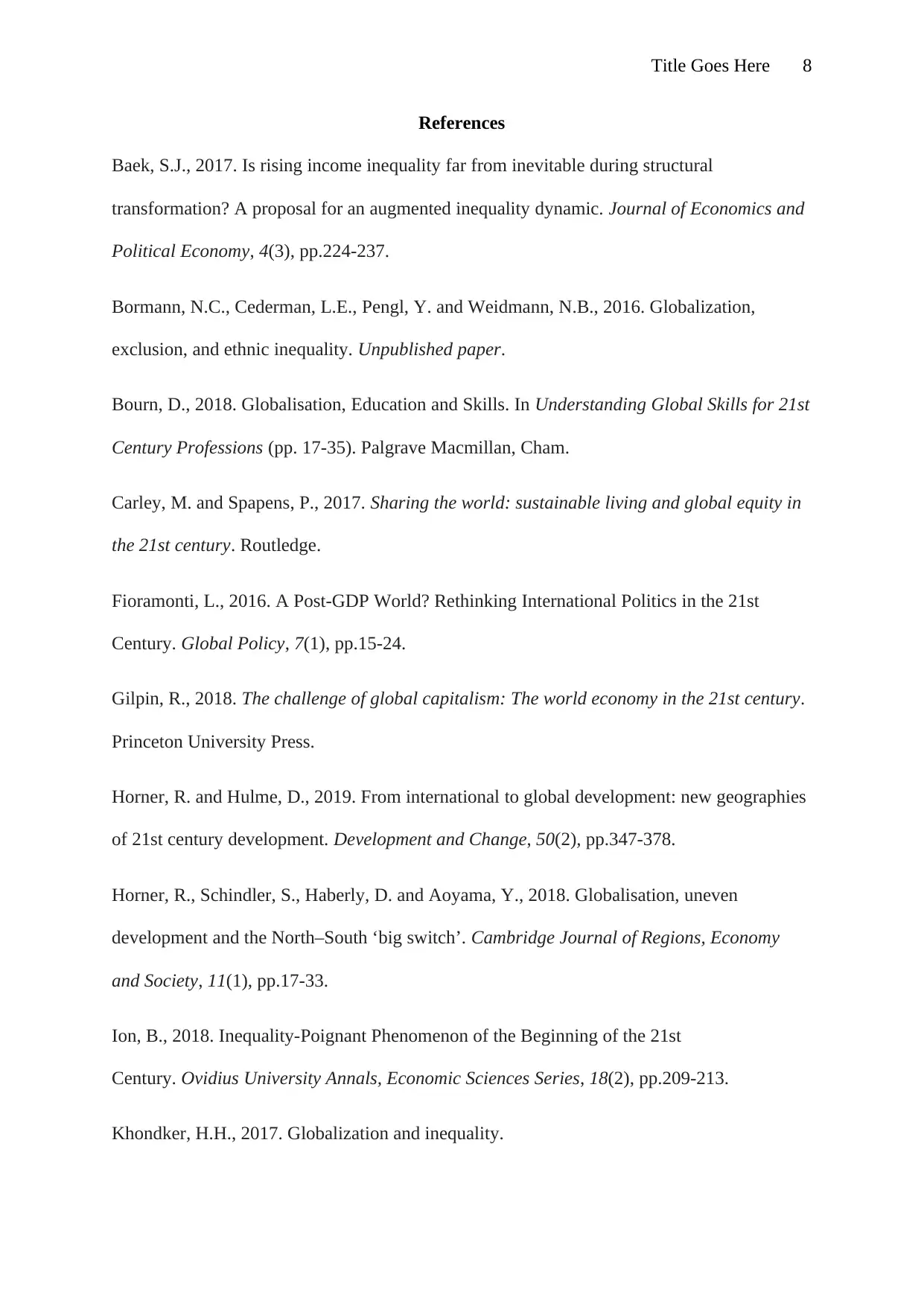
Title Goes Here 8
References
Baek, S.J., 2017. Is rising income inequality far from inevitable during structural
transformation? A proposal for an augmented inequality dynamic. Journal of Economics and
Political Economy, 4(3), pp.224-237.
Bormann, N.C., Cederman, L.E., Pengl, Y. and Weidmann, N.B., 2016. Globalization,
exclusion, and ethnic inequality. Unpublished paper.
Bourn, D., 2018. Globalisation, Education and Skills. In Understanding Global Skills for 21st
Century Professions (pp. 17-35). Palgrave Macmillan, Cham.
Carley, M. and Spapens, P., 2017. Sharing the world: sustainable living and global equity in
the 21st century. Routledge.
Fioramonti, L., 2016. A Post‐GDP World? Rethinking International Politics in the 21st
Century. Global Policy, 7(1), pp.15-24.
Gilpin, R., 2018. The challenge of global capitalism: The world economy in the 21st century.
Princeton University Press.
Horner, R. and Hulme, D., 2019. From international to global development: new geographies
of 21st century development. Development and Change, 50(2), pp.347-378.
Horner, R., Schindler, S., Haberly, D. and Aoyama, Y., 2018. Globalisation, uneven
development and the North–South ‘big switch’. Cambridge Journal of Regions, Economy
and Society, 11(1), pp.17-33.
Ion, B., 2018. Inequality-Poignant Phenomenon of the Beginning of the 21st
Century. Ovidius University Annals, Economic Sciences Series, 18(2), pp.209-213.
Khondker, H.H., 2017. Globalization and inequality.
References
Baek, S.J., 2017. Is rising income inequality far from inevitable during structural
transformation? A proposal for an augmented inequality dynamic. Journal of Economics and
Political Economy, 4(3), pp.224-237.
Bormann, N.C., Cederman, L.E., Pengl, Y. and Weidmann, N.B., 2016. Globalization,
exclusion, and ethnic inequality. Unpublished paper.
Bourn, D., 2018. Globalisation, Education and Skills. In Understanding Global Skills for 21st
Century Professions (pp. 17-35). Palgrave Macmillan, Cham.
Carley, M. and Spapens, P., 2017. Sharing the world: sustainable living and global equity in
the 21st century. Routledge.
Fioramonti, L., 2016. A Post‐GDP World? Rethinking International Politics in the 21st
Century. Global Policy, 7(1), pp.15-24.
Gilpin, R., 2018. The challenge of global capitalism: The world economy in the 21st century.
Princeton University Press.
Horner, R. and Hulme, D., 2019. From international to global development: new geographies
of 21st century development. Development and Change, 50(2), pp.347-378.
Horner, R., Schindler, S., Haberly, D. and Aoyama, Y., 2018. Globalisation, uneven
development and the North–South ‘big switch’. Cambridge Journal of Regions, Economy
and Society, 11(1), pp.17-33.
Ion, B., 2018. Inequality-Poignant Phenomenon of the Beginning of the 21st
Century. Ovidius University Annals, Economic Sciences Series, 18(2), pp.209-213.
Khondker, H.H., 2017. Globalization and inequality.
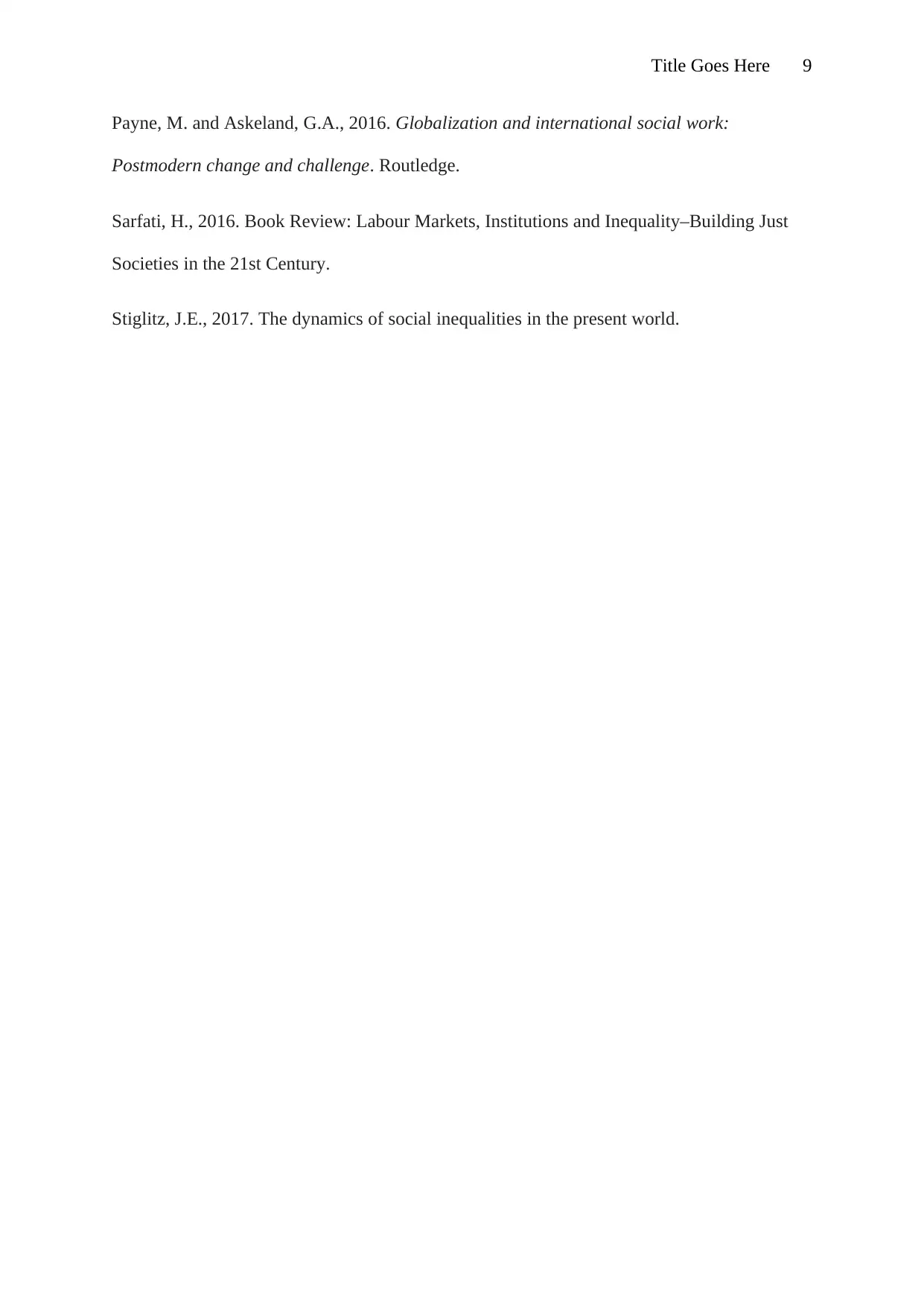
Title Goes Here 9
Payne, M. and Askeland, G.A., 2016. Globalization and international social work:
Postmodern change and challenge. Routledge.
Sarfati, H., 2016. Book Review: Labour Markets, Institutions and Inequality–Building Just
Societies in the 21st Century.
Stiglitz, J.E., 2017. The dynamics of social inequalities in the present world.
Payne, M. and Askeland, G.A., 2016. Globalization and international social work:
Postmodern change and challenge. Routledge.
Sarfati, H., 2016. Book Review: Labour Markets, Institutions and Inequality–Building Just
Societies in the 21st Century.
Stiglitz, J.E., 2017. The dynamics of social inequalities in the present world.
⊘ This is a preview!⊘
Do you want full access?
Subscribe today to unlock all pages.

Trusted by 1+ million students worldwide
1 out of 9
Related Documents
Your All-in-One AI-Powered Toolkit for Academic Success.
+13062052269
info@desklib.com
Available 24*7 on WhatsApp / Email
![[object Object]](/_next/static/media/star-bottom.7253800d.svg)
Unlock your academic potential
Copyright © 2020–2025 A2Z Services. All Rights Reserved. Developed and managed by ZUCOL.





